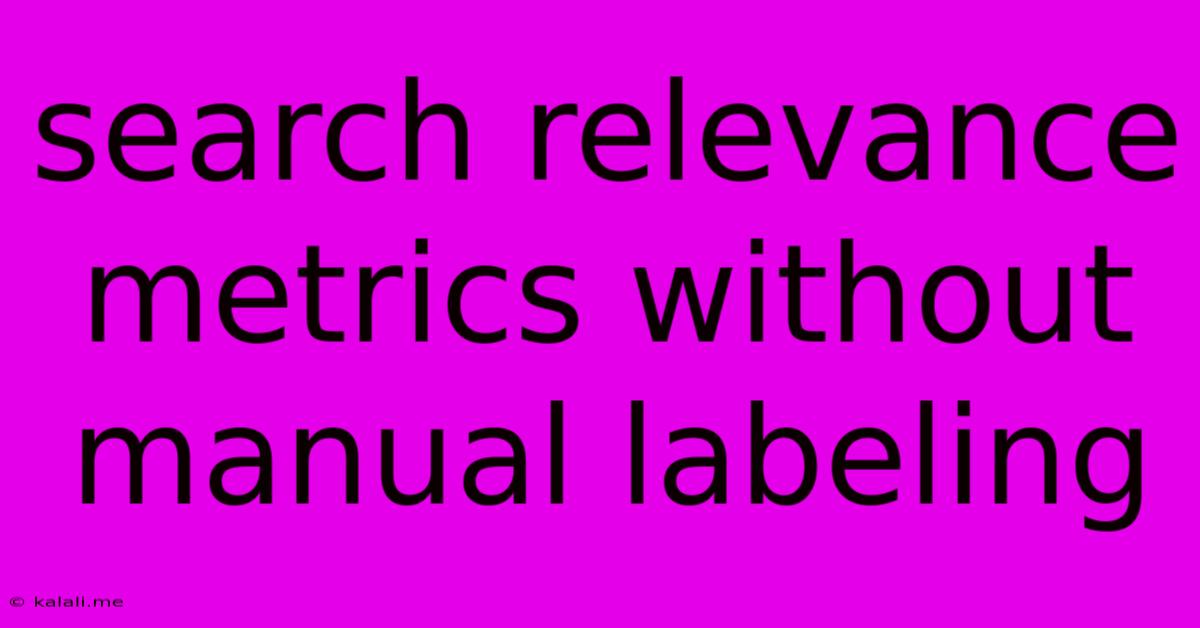Search Relevance Metrics Without Manual Labeling
Kalali
Jun 09, 2025 · 3 min read

Table of Contents
Search Relevance Metrics Without Manual Labeling: A Deep Dive into Unsupervised Methods
Meta Description: Discover how to measure search relevance without the costly and time-consuming process of manual labeling. This article explores unsupervised methods like BM25, language models, and clickstream data analysis, offering insights into their strengths and weaknesses.
Ranking search results effectively is crucial for any search engine. Traditionally, this relied heavily on manual labeling of search results to determine relevance. However, this process is expensive, time-consuming, and prone to human bias. This article delves into powerful, alternative methods for evaluating search relevance that don't require manual labeling – paving the way for more efficient and unbiased search engine optimization (SEO) strategies.
The Limitations of Manual Labeling
Manual labeling, while offering high accuracy in smaller datasets, suffers from several significant drawbacks:
- Cost and Time: Manually labeling a large dataset of search results is prohibitively expensive and takes considerable time.
- Scalability Issues: Maintaining relevance judgments as the search landscape constantly evolves is an enormous task.
- Subjectivity and Bias: Human annotators may have differing interpretations of relevance, leading to inconsistencies and bias in the dataset.
These limitations necessitate the exploration of alternative, unsupervised methods for assessing search relevance.
Unsupervised Methods for Evaluating Search Relevance
Several sophisticated techniques can effectively measure search relevance without relying on manual labeling. These methods leverage readily available data and sophisticated algorithms to infer relevance:
1. BM25 and Other Term Frequency-Inverse Document Frequency (TF-IDF) Based Metrics
BM25 (Best Match 25) is a widely used ranking function that scores the relevance of documents to a given query. It's based on the TF-IDF principle, considering the frequency of terms in both the query and the document, while adjusting for the inverse document frequency (how common a term is across all documents). While not explicitly a relevance metric, its effectiveness in ranking results makes it an indirect indicator of relevance. Variations and improvements upon BM25 continue to be developed.
2. Language Models for Relevance Estimation
Language models, particularly those based on neural networks (like BERT, RoBERTa), can effectively capture the semantic relationship between queries and documents. By assessing the probability of a document given a query, these models provide a measure of relevance. These advanced language models often outperform traditional TF-IDF based approaches in capturing nuances of language and context.
3. Clickstream Data Analysis
Analyzing user clickstream data provides invaluable insights into relevance. This data reveals which results users actually click on after performing a search. While not a direct measure of relevance, high click-through rates (CTR) on specific results strongly suggest higher perceived relevance. Analyzing click patterns can help refine search algorithms and improve overall ranking accuracy. However, it's crucial to account for positional bias, where top-ranked results often receive more clicks regardless of their true relevance.
4. Implicit Feedback Signals
Beyond clickstream data, other implicit feedback signals can contribute to relevance assessment. These include dwell time (how long a user spends on a page), bounce rate (percentage of users who leave after viewing only one page), and the number of pages visited within a session related to the initial search. These signals offer a richer understanding of user engagement and satisfaction, providing indirect but valuable measures of relevance.
Choosing the Right Method
The optimal method for evaluating search relevance without manual labeling depends on several factors:
- Data Availability: Clickstream data is readily available for most search engines, while training language models requires substantial computational resources.
- Computational Resources: Language models demand considerable computational power, whereas BM25 is relatively lightweight.
- Desired Level of Accuracy: Language models generally offer higher accuracy than simpler methods like BM25.
A hybrid approach, combining multiple methods, may provide the most robust and comprehensive assessment of search relevance.
Conclusion
Moving beyond manual labeling opens doors to more scalable, efficient, and unbiased methods for evaluating search relevance. By leveraging unsupervised techniques like BM25, language models, and clickstream data analysis, search engines can continuously improve their ranking algorithms and provide users with more relevant and satisfactory search experiences. The future of search relevance metrics lies in the intelligent combination of these powerful methods, ensuring the ongoing refinement and optimization of search technology.
Latest Posts
Latest Posts
-
Four Letter Word With Second Letter A
Jul 01, 2025
-
How Many 1 8 Cups Are In 2 3 Cup
Jul 01, 2025
-
How Many Slices Of Turkey In 2 Oz
Jul 01, 2025
-
Omnipoint Miami E License Llc Miami Fl
Jul 01, 2025
-
Mi Familia Fuera La M S Grande Correct Incorrect
Jul 01, 2025
Related Post
Thank you for visiting our website which covers about Search Relevance Metrics Without Manual Labeling . We hope the information provided has been useful to you. Feel free to contact us if you have any questions or need further assistance. See you next time and don't miss to bookmark.